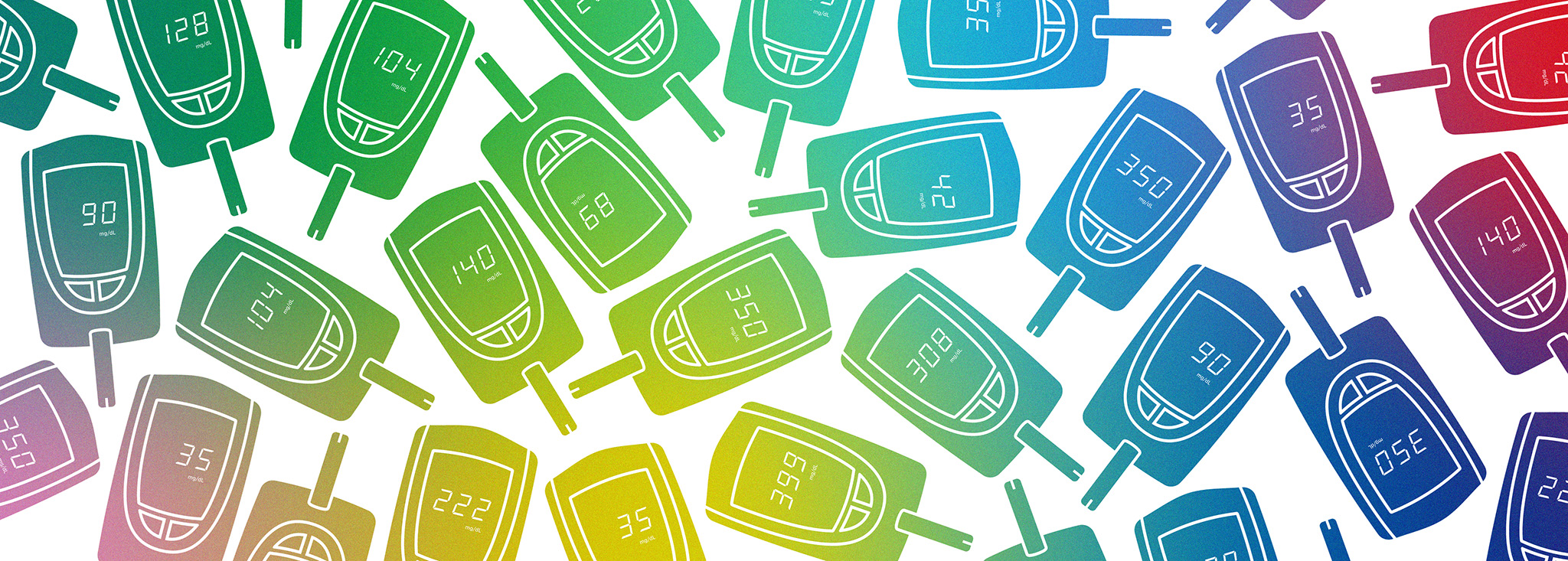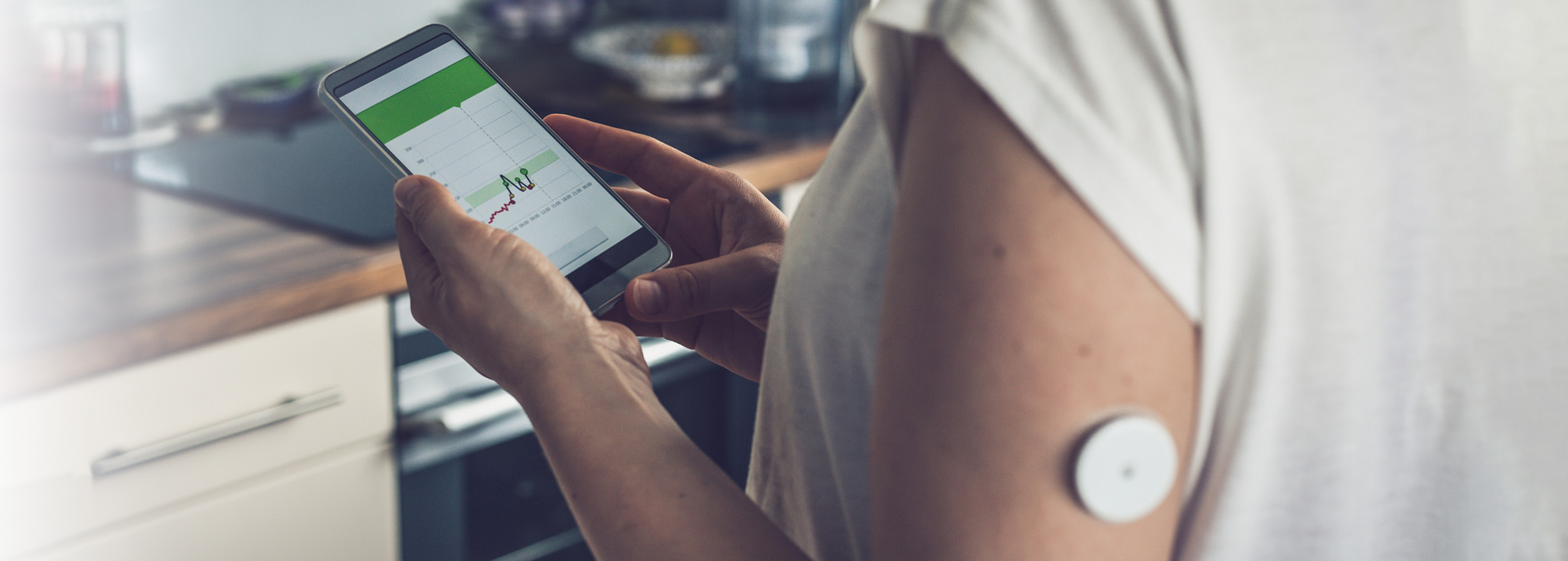All About Time-in-Range
Written by: Ginger Vieira
7 minute read
April 21, 2021
Once upon a time, your HbA1c result was the ultimate measure of a person’s blood sugar management. For people with type 1 and type 2 diabetes, the “A1c” test became a routine part of your quarterly diabetes check-up in the early 90s.
Today, the measure of “time-in-range” (TIR) has become a potentially more valuable method of assessing blood sugar management thanks to the development of continuous glucose monitoring (CGM).
Let’s take a closer look at TIR and how it can help you in daily diabetes management.
What is time-in-range?
Time-in-range (TIR) is a measurement that tells you what percentage of the day your blood sugars are in your goal range.
While using a CGM, you’ll work with your healthcare team to set “low” and “high” alarms that determine the appropriate goal range for your blood sugar levels. TIR tells you how often you’re actually within that goal range.
For example, your personal TIR might be an average of 65 percent in a goal range of 4.4 to 10.0 mmol/L80 to 180 mg/dL. This means your blood sugar levels are within that range for about 65 percent of the day. This means that your blood sugars are higher or lower than that range for the remaining 35 percent of the day. The ADA refers to these as “time below range” (TBR) and “time above range” (TAR).
Today’s CGM technology can also offer more in-depth detail (graphs, charts, etc.) about your blood sugar levels with software like:
Measuring TIR is made possible with a CGM because this technology takes new readings of your blood glucose levels every five minutes. While a person could gather this amount of data with a traditional blood glucose meter and finger sticks, it isn’t feasible or realistic for most people. (Not to mention, it would be quite a painful day for your fingertips!)
TIR vs. A1c: What’s the difference?
Discovered in 1968, your A1c result is still valuable, but it can overlook some critical aspects of your blood sugar levels, your safety and your overall wellbeing as a person with diabetes.
“I place immense value on time in-range because it relates directly to a person’s quality of life,” says Gary Scheiner, CDCES, MS, author of Think Like a Pancreas, and founder of Integrated Diabetes Services.
While an A1c measurement gives you a general idea of your eAG (estimated average glucose level), it won’t tell you if you’re experiencing several severe low blood sugars every day or bouncing from high to low on a regular basis. It simply provides an insight into the middle of that range. Frequent low blood sugars could also result in an artificially lower A1c result.
A1c levels are also considered a flawed measurement compared to TIR because your A1c measures the glucose attached to the red blood cells in your body, but it’s only measuring a small percentage of those red blood cells. Additionally, the newer the red blood cell is, the less attached glucose there will be, and the rate at which a person creates new red blood cells can vary wildly from person-to-person, and during other variables like pregnancy or if you just donated blood. In other words: it’s simply not a very accurate assessment of blood sugar health.
In TIR, the only variable is the general accuracy of your CGM and how often you’re wearing it. Otherwise, it can paint a very clear picture of where your blood sugars are on a day-to-day basis.
Editor’s Note: Click here for more info from ADA 2020 debating the use of A1C vs TIR in Pediatric Diabetes Care.
What should your “goal range” be for blood sugar levels?
While many of us would like our blood sugars to be between 3.9 to 6.7 mmol/L70 to 120 mg/dL all day long, that’s neither realistic nor necessary for most. Determining the right goal range for you can depend on a variety of factors, including:
- Age (young child vs. teenager vs. adult vs. senior citizen)
- Experience in managing diabetes
- Access to diabetes education
- Experience in managing insulin
- Ability to feel symptoms of low blood sugar
- Past experience or trauma with severe hypoglycemia
- Access to diabetes medications
- Access to diabetes technology
- How you personally feel at different blood sugar levels
- Managing diabetes during pregnancy
- Managing diabetes amidst other health issues
- Lifestyle factors like being a parent, driving a lot, intense activity level, etc.
“It should be customized to the individual,” says Scheiner. “The universal range of 3.9 to 10.0 mmol/L70 to 180 mg/dL does not apply to everyone. The thing about time-in-range is that you have to first decide what that ‘feel good’ range is for you.”
While someone eating a very strict low-carb diet might be comfortable at 4.2 mmol/L75 mg/dL because they take very small doses of insulin, potentially minimizing their risk of hypoglycemia, that might feel too risky for someone eating a diet higher in carbohydrates or a parent of two small children or someone who is driving their car all day for work.
“Some people are more comfortable on the slight higher side,” says Scheiner, “and others find their happy zone when blood glucose levels are very tight.”
For someone who’s experienced a seizure during a severe low blood sugar, lingering below 5.5 mmol/L100 mg/dL could trigger a great deal of anxiety, which means you may need a higher goal range as you address that trauma.
What is a healthy “time-in-range” goal?
The first and most important detail regarding your “time-in-range” percentage is really about the amount of time you are below range—your TBR.
Low blood sugars are not only uncomfortable and tedious, they’re also dangerous. The Association of Diabetes Care & Education Specialists (ADCES) provides the following guidelines regarding TIR range goals depending on age and pregnancy.
Keep in mind that these guidelines are designed to help you stay as healthy as possible while also minimizing your risk of severe hypoglycemia.
| Person with diabetes | Blood sugar range | Time-in-Range (hours/day) | Time-Below-Range (hours/day) | Time-Above-Range (hours/day) |
|---|---|---|---|---|
| Adults with type 1 & type 2 | 3.9-10.0 mmol/L70-180 mg/dL | >70% (about 17 hours | <5% (just over 1 hour) | <30% (about 7 hours) |
| High-risk for lows (children & elderly) | 3.9-10.0 mmol/L70-180 mg/dL | >50% (about 12 hours) | <1% (about 15 minutes | <10% (about 2.5 hours) |
| Pregnancy with type 1 diabetes | 3.5-7.8 mmol/L63-140 mg/dL | >50% (about 12 hours) | <5% (just over 1 hour) | <25% (about 6 hours) |
| Pregnancy with type 2 or Gestational diabetes | 3.5-7.8 mmol/L63-140 mg/dL | >90% (about 21 hours) | n/a | n/a |
It’s also important in assessing your TIR to know that achieving a higher TIR percent might mean you see a slight increase in your A1c if you’ve significantly reduced the amount of hypoglycemia you experience. This is a good thing, and it’s another example of why the TIR tells you more than your A1c might.
“Clearly, we try to minimize time in a hypoglycemic zone, less than 3 percent is ideal for most people,” adds Scheiner. “But other than that, the optimal percentages depend on your personal high and low thresholds, and your personal goals and capabilities.”
Talk to your healthcare team to discuss your personal TIR and your goals.

Author
Ginger Vieira
Ginger Vieira is an author and writer living with type 1 diabetes, celiac disease, fibromyalgia and hypothyroidism. She’s authored a variety of books, including “When I Go Low” (for kids), “Pregnancy with Type 1 Diabetes,” and “Dealing with Diabetes Burnout.” As the Digital Content Manager for BeyondType1, Ginger’s also written for Diabetes Mine, Healthline, T1D Exchange, Diabetes Strong and more! In her free time, she is jumping rope, scootering with her daughters, or walking with her handsome fella and their dog.
Related Resources

Your blood sugar data might as well be a gold mine to your healthcare team....
Read more

The data you gain from diabetes technology—like continuous glucose monitors (CGMs)—can be so helpful, but...
Read more

Many people with diabetes not only depend on their insulin but important technology like continuous...
Read more

